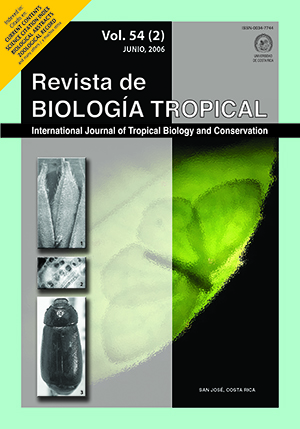Abstract
Availability of toxics in aquatic bodies is limited by the physicochemical characteristics of sedi-ments and water, as well as by the interactions between the different xenobiotics and inhabits species. The aim of this work was to relate the effect produced by zinc (Zn) spiked in sediments of the Ignacio Ramírez dam (PIR), in isolated and microcosms models, on ATP concentration of three benthic organisms with the metal bio-disponibility. The selected species were a crustacean, an annelid and a mollusk: Hyalella azteca (Amphipoda: Hyalellidae),Limnodrilus hoffmeisteri (Oligochaeta: Tubificidae) and Stagnicola attenuata (Basommatophora:Lymnaeidae), species that are found at high proportions in the reservoir and use different spaces in the benthos. Samples of sediments and organisms were collected from the PIR during the dry season (February of 1999). Metal concentration (Zn, Fe, Cu and Ni), pH, texture, particle size, total nitrogen and organic matter were deter-mined in sediments. Sublethal studies were carried out using two types of static systems (organisms isolated and in microcosms). Both models contained PIR sediments enriched with Zn (nominal concentration of 0.8129 mg/kg) and synthetic water in a proportion of 1:4. The test organisms were added to the systems once the equi-librium was reached (2 hr) considering the biomass quantity with respect to volume (1.0 g of organism by each 100 ml of water:sediment). After 0, 12, 24, 36, 48 and 72 hr of exposure, samples of sediment and hydrobionts were taken, and Zn content was quantified by atomic absorption. ATP concentration was also determined in organisms. The effect produced by natural sediments spiked with Zn is increased by the presence of more than one specie in the system (microcosm). With respect to Zn levels, two of the organisms tend to lose this metal in isolated and microcosm models, probably as a regulation strategy in its accumulation, as well as Fe presence in the reservoir sediments. Therefore, H. azteca maintained a constant Zn levels during the whole experiment. It is possible that the caption rate is so low in this organism that it does not need another regulatory mechanism. A decrement in ATP in worms and amphipods was observed in both systems at all exposure times. Possibly Zn and other metals present in the sediments interfere with the energy production enzymes by binding to SH groups. Nevertheless this biomolecule increased in snails in microcosms at all exposure times and in isolatedsystems at the end of the experiment, probably due to compensatory mechanisms and reduction in energy consumption present in mollusks during heavy metals exposure.
##plugins.facebook.comentarios##

This work is licensed under a Creative Commons Attribution 4.0 International License.
Copyright (c) 2006 Revista de Biología Tropical






